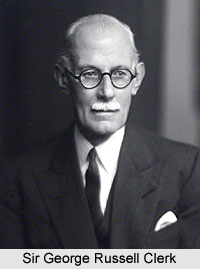 George Russell Clerk, formally addressed as Sir George Russell Clerk, GCSI, KCB, was one of the Governors of Bombay Presidency in the year 1937. He was also one of the renowned a colonial administrators. Clerk also served as one of the members of the British Indian Civil Service. The members of the civil service were appointed under Section XXXII of the Government of India Act, 1858 of the Parliament of the United Kingdom. After the year 1886, the Indian Civil Service was officially known as Imperial Civil Service.
George Russell Clerk, formally addressed as Sir George Russell Clerk, GCSI, KCB, was one of the Governors of Bombay Presidency in the year 1937. He was also one of the renowned a colonial administrators. Clerk also served as one of the members of the British Indian Civil Service. The members of the civil service were appointed under Section XXXII of the Government of India Act, 1858 of the Parliament of the United Kingdom. After the year 1886, the Indian Civil Service was officially known as Imperial Civil Service.
George Russell Clerk was born in the year 1800 and received his education from Haileybury in Hertfordshire. After the successful completion of his graduation, Clerk was positioned to Bengal as a writer in the year 1817. Early in his career, Clerk was employed in the Political and Secret Department of the Government and most of his consequent work was in that line of business. He acted as an Assistant to the President in Rajputana and Delhi. Later he was assigned as a Political Agent, also known as Resident of British India, at Ambala and eventually at Ludhiana in the year 1839. Sir George Russell Clerk, GCSI, KCB also acted as the Political Agent of Lahore in the year 1840.
In the year 1843, he was assigned as the Lieutenant Governor of the North Western Provinces. Then Sir George Russell Clerk was then appointed Governor of Bombay and served in the position from 1848 to 1850. Clerk was appointed as the Governor of Bombay Presidency for a second time on 11 May 1860 and was preceded by Sir John Elphinstone, 13th Lord Elphinstone and 1st Baron Elphinstone GCB GCH PC, who retired as the Governor of Bombay in 1860. Bombay Presidency was first founded in the 17th century at Surat as a trading post for the British East India Company. The Presidency included the territories of modern states of Gujarat, Maharashtra, regions of Konkan, Kandesh and Desh and northwestern Karnataka state. George Russell Clerk served in office till 24 April 1862 and was succeeded by Sir Henry Bartle Edward Frere, 1st Baronet, GCB, GCSI.
Later Sir George Russell Clerk was appointed as the first Permanent Under Secretary of State for India. He also became a member of the Council of India. He served in the position until 1876. He was knighted with Knight Grand Commander of The Most Exalted Order of the Star of India (GCSI) and Knight Commander of The Most Honourable Order of the Bath (KCB). Clerk died in the year 1889.



















